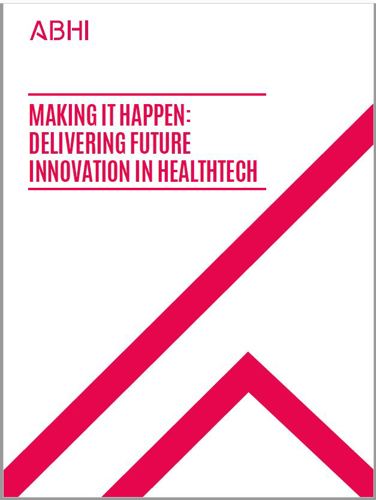Making it Happen: Delivering Future Innovation in HealthTech
Topic : Innovation Type : Report
As the largest employer in the broader Life Sciences Sector, HealthTech (medical devices, diagnostics and digital health technologies currently employs 131,800 people in 4,060 companies, with a combined turnover of £25.6bn, and has enjoyed annual growth of around 5% in recent years. The UK represents roughly 5% of the global industry, and HealthTech is set to remain a key driver of economic growth in our country, and is an industry government has committed to supporting.
Although the UK is seen as a key market, a recent survey of UK HealthTech companies showed 70% have experienced rising costs of regulation, over a third see the NHS as an increasingly expensive customer to serve, and almost two thirds were negatively impacted by COVID-19. Despite this, there are significant opportunities. Whilst almost half of companies in the sector do not currently have either R&D or manufacturing facilities in the UK, a quarter are currently looking to expand here in the next year. There are also some signs that companies are beginning to view the UK market with increasing confidence, although for many this will depend on how quickly elective care returns consistently towards its pre-COVID-19 levels.
In the 1990s and 2000s, the NHS made large investments to reduce waiting times for planned surgery. Referral to treatment times remain low by historic standards, and GP referrals are flat, but in recent years treatment capacity has not grown fast enough to keep up with patient need, and the number of patients waiting longer than 18 weeks has been steadily increasing. The situation has been dramatically exacerbated by the COVID-19 pandemic. At the start of the pandemic around 1,600 people were waiting more than 52 weeks for treatment, that figure is now in excess of 436,000 and is set to grow as patients begin to re-enter the system. Furthermore, the NHS Confederation estimates that the total number of people on waiting lists could be above 5 million (June 2021 figures).
It is 20 years since Sir Derek Wanless described the NHS as a late and slow adopter of technology and in the intervening years there have been many initiatives aimed at addressing this. The response to the pandemic has demonstrated that the NHS can be as agile and fleet-footed as any other healthcare system in the world, and now, we must not only build on the lessons learnt, we must also strive to overcome some of the more systemic challenges that still remain.
This report aims to provide recommendations for how the UK can work collaboratively to achieve both aims, and ensure innovation is encouraged for the benefit of patients, the NHS and the wider UK economy.
The recommendations (summarised on pages 6-10) focus on areas identified as critical to innovation, and are described as key drivers for the industry and the enablers required to achieve them.
Key drivers:
- Sustaining positive pandemic response innovation
- Building an early diagnosis culture
- Increasing the delivery of remote care
Key enablers:
- A HealthTech champion
- Research, development and manufacture of technologies
- Developing our new regulatory system
- Effectively evidencing and evaluating innovation
- Encouraging the rapid adoption of technology
- Supporting value-based procurement
- Improving access to finance
- Maintaining and expanding existing successful initiatives
Download the full report below:





